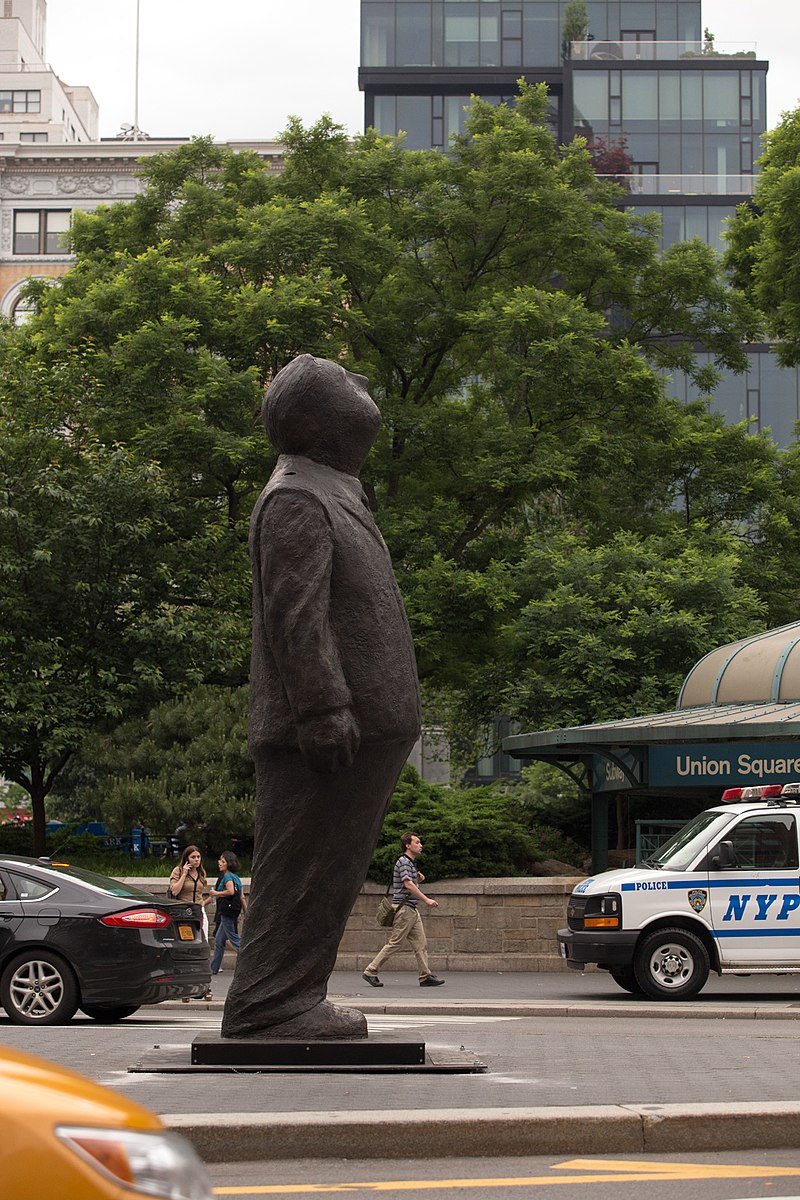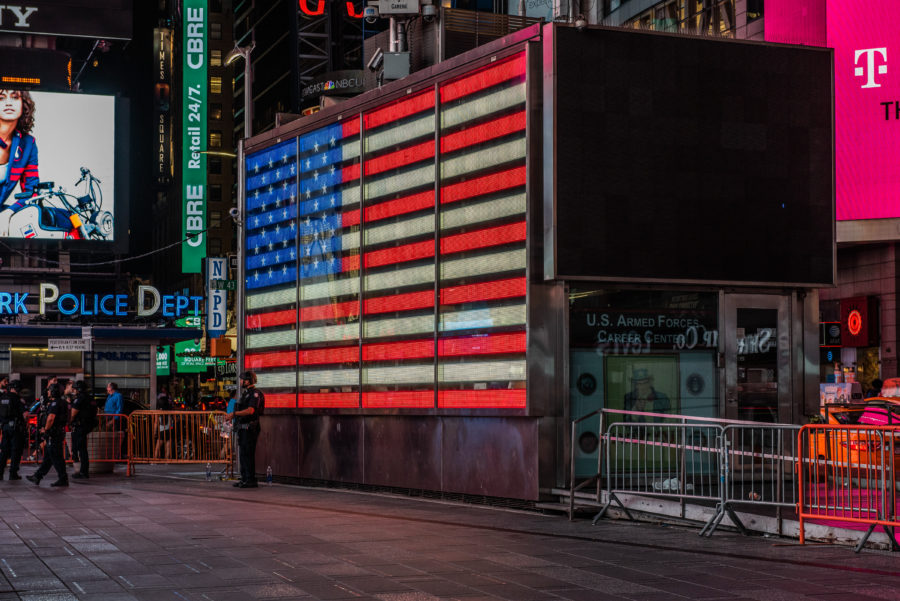Banality is the byword of mass consumerism
There’s a piece of public art that for a year or more languished on the edges of Union Square in Manhattan, before moving to a more innocuous location in Midtown.
It’s a piece of bronze and laser cut steel in the form of a thick-waisted businessman, peering up into the sky. The statue, by Jim Rennert, is called, “Think Big.” This rotund figure struck me as a bizarre but predictable contrast with Union Square itself, site of labor protests, political demonstrations, and various working class events over the past century and a half.
Then, on its cusp, a fattened, besuited, becalmed, moronic middle-manager stands, gazing into the clouds wonderingly. The figure itself looks like the Everyman of modern capital, depicted in the altruistic framing of business propaganda: a harmless, innocent, well-intentioned, exceedingly milquetoast middle-aged man of the people who does his earnest best to help his genteel corporation make a tidy profit, and drawing his modest share of the revenues to support his family. What could be wrong with that?
Aside from the stomach-churning inanity of it, the statue has elided every conceivable aspect of its form that might imply or evince the raging class war between workers and suit-wearing corporate servants, themselves alighted like parasites on the broad husk of the Big Capital. A class war that is blood-soaked and pitiless.
Yet our statue goes to great lengths to present the antithesis: the anodyne complacency of the humming mid-century office space, a hive of drones doing their daily duty. It is truly nondenominational, reflecting the most catholic of images, the most generic.

“Think Big is a sculpture that serves to inspire everyone who works hard every day to achieve their dreams and goals. The towering businessman gazes upward at the Manhattan skyline, contemplating the possibilities that lay within his vast surroundings and reminding us that if we “think big” any dream is attainable.” – jimrennert.com
Ersatz Replica
Philosopher and aphorist E.M. Cioran once wrote that, “Existing is plagiarism.” If to be is to simply be an ersatz replica of the palatable, then why exist, either as individual, artist, or work of ‘art’? Nobody has asked Rennert.
The statue, the name of which is like much modern advertising – quite clearly it is the first name that entered the brain of the artist (or advertiser, as the case may be). Thinking big, as it were, entails thinking big on behalf of the corporation for which you work; the ideas are not truly your own; the mission of the business is not your mission (unless you internalize it); and the life trajectory, even, is one set by the whim of the corporate market to which you sell your labor.
Rather differently, the labor strikes and protests that once occurred in this space, were fuelled by men and women fighting to have all of the things elided by the statue, shaved away by the sculptor’s judicious hand: your own mission; your own ideas; your own life and career trajectory. Thus, Herbert Marcuse wrote: ‘Men do not live their own lives but perform pre-established functions. While they work, they do not fulfill their own needs and faculties, but work in alienation.’
How well the Think Big man resembles this perception: a drone, like others in appearance and wardrobe and function, alienated from his own desires, subordinated to those of a faceless overlord of industry. As a representation of the Professional Managerial Class (PMC), it is equally apt, as that class sits as a bourgeois buffer between elitism and populism, between a secular aristocracy and the abject proletariat, both classes growing exponentially so that the metaphorical abyss widens in two senses: vertically and horizontally.
This bourgeois buffer provides an aesthetic disguise for the dirty business of capitalism. They are not the sweat-drenched coltan miners in the Congo, but the svelte marketers who ply the ether with iPhone ads. His hard edges have been sanded down; he is perfectly polished, nonthreatening, inoffensively bland.

Eugene V. Debs five times candidate of the Socialist Party of America for President of the United States.
Virtue Hoarders
In her book Virtue Hoarders, Catherine Liu historicizes this class. As the Socialist Left in America was progressively destroyed by the public relations efforts of big business, the haute bourgeoisie sided with capital. She writes:
When the tide turned against American workers, the PMC preferred to fight culture wars against the classes below while currying the favor of capitalists it once despised. The culture war was always a proxy economic war, but the 1960s divided the country into the allegedly enlightened and the allegedly benighted, with the PMC able to separate itself from its economic inferiors in a way that seemed morally justifiable.
She describes them as ‘salaried mental workers,’ including doctors, lawyers, advertising managers, IT professionals, and bank managers who reproduce the status quo, having abandoned political radicalism in favor of cultural wars and careerism.
This is the buffer class, idealized in the sanitized vision of Think Big. Yet Think Big betrays the idea of simple reproduction, revealing the compulsion of neoliberalism to shave cost to stave a falling rate of profit. As Liu puts it:
In the United States, generations of allegedly neutral experts have hollowed out public goods, degraded the public sphere, facilitated the monetization of everything from health to aptitude, and indebted generations of Americans in a fantasy of meritocracy enhanced social mobility. Liberals have sat by while finance capital and corporate interests gutted the public treasury.

Image: © Constantino Idini.
Delirium
E.M. Cioran says Western societies are beholden to – fatally obsessed with – technology, innovation, and the drive of capitalism for rapid obsoletion, and the process of ceaseless enhancement and replacement. He says they are in a state of ‘delirium,’ but adds (in Drawn and Quartered) that this kind of breathless preoccupation with novelty is itself relatively new in history:
Archaic societies have lasted so long because they know nothing of the desire to innovate, to grovel before ever-new simulacra. If you change images with each generation, you cannot anticipate historical longevity. Classical Greece and modern Europe typify civilizations stricken by a precocious death, following a greed for metamorphosis and an excessive consumption of gods, and of the surrogates for gods. Ancient China and Egypt wallowed for millennia in a magnificent sclerosis. As did African societies, before contact with the West.
Given that societies are anchored in historical circumstance, they are subject to the same iron law of all civilizations, that they will eventually ‘sag and settle’ as the initial dynamism dies. How much more likely in a society built on an idée fixe, a fetishistic mania.
And yet – small consolation for those whose lives are on a far faster downward trajectory than civilization itself.
Hence the siren call of rebellion will continue to outline itself precisely against this insipid, pulseless figure paradoxically anchored at the center of a monomaniacal society. A society the signature of which is the fixity of its preoccupation with profit – and the consumption that enables it.

U.S. President Donald Trump displays the signed Executive Order for the Establishment of a Presidential Advisory Commission on Election Integrity on May 11, 2017.
The American Dream and Authenticity
This cultural underbelly outlined above is eviscerated not just by the corporate art we are confronted with, but by the modern narrative of the American Dream™ ; this statue is just a recent embodiment of it.
Anyone, color and creed aside, through their efforts and ingenuity, can do or be anything they wish to be. No material circumstances obtain in their pursuit of happiness. Class is a byword of another era, trampled underfoot by the ascent of free-market capitalism, which brooks no discriminatory practice in its market-rendered even-playing field.
As any sentient being can observe, this is a historical fiction, a deceit reproduced daily through the channels of mass media and its advertising, entertainment, and news content, all of which is owned and operated by elite capital and managed by its flyblown class of sycophants.
Essayist and playwright John Steppling gets at much the same thing in his book Aesthetic Resistance And Dis-Interest (2016). He writes, in the context of the dissolution of art as an anchor of culture, of the loss of art’s radical conscience in favor of corporate cliche.
Steppling would despise the ‘Think Big’ statue. Its banality is that of a Jeff Koons work, the more celebrated the less memorable. He argues that mass electronic screen culture has destroyed something critical in the collective consciousness, namely the space for authentic art.
He also notes that art is radical insofar as it refuses to adopt particular meanings, just as space is forever unyoked to purpose, yet radically ratifies none, and is the necessary background to all purpose.
He quotes Robert Kullot-Kentor, biographer of Theodor Adorno, ‘Art’s truth appears guaranteed more by its denial of any meaning in organized society…’ As Steppling later adds, ‘It’s purposelessness is its radical expression.’
And again: ‘Art is self destructive. It is guided by impulses that are anti-social, but only insofar as they question the status quo, because the status quo cannot survive history or memory.’
What artists like Rennet and Koons produce is effortlessly mainstream; it doesn’t challenge the status quo but rather reifies it. It is therefore not art. There is no question posed by the skygazing statue, no threat emerges. It is the reproduction of the placid mind of endless consumption, of ceaseless salesmanship, the mind of the individual cog in a system that it neither sees nor questions. Deification of the quotidian.
Following the Futurists, who wanted to break the compliance of passive consumption, Ella de Burca asserts a necessary role for Art to challenge and provoke.https://t.co/j3ou4RkUvC@broadsheet_ie @BowesChay @IlsaCarter1 @danieleidiniph1 @itsmybike @AlanGilsenan1 @KevinHIpoet1967
— CassandraVoices (@VoicesCassandra) October 7, 2021
Steppling says the clue to the decay of society is the sense that culture is themed by ‘the inauthentic and counterfeit.’
That sensibility, that sinking feeling, for me, is most evident in the hypocrisy of modern advertising. Ads relentlessly tell us they are making commodities to make our lives better – that is their mission and purpose. Yet that is a half-truth at best, a full-blown deceit on a bad day.
Products are produced for profit, first and foremost. They are made to solve the sometimes real but largely artificial needs of consumers only insofar as they must. The initial aim of the product line is the MVP, or Minimally Viable Product.
This is the industry jargon for a commodity that meets the minimum threshold for sale-ability. Beyond that – innovations that improve the product – are seen as incurred costs, unnecessary but sometimes preferable if the cost-benefit analysis predicts higher profits with higher quality. This corrosive smile that fronts modern culture is the clue to the erosion of meaning but also somehow echoes the voice of the Cassandra exposing its desiccated spirit, having submitted itself to the hegemonic ideal, represented by the bland everyman that serves none but the needs of blind profit.
Dr Marcus de Brun argues that the origins of advertising lie in the ancient debate between Socrates and the Sophists who proved facile arguments with true facts.https://t.co/1A6zJsP5MB@indepdubnrth @broadsheet_ie @PD03662439 @connolly16frank @PaulGilgunn @IlsaCarter1
— CassandraVoices (@VoicesCassandra) December 11, 2020
Mass Infantilism
Alongside the denuded character of the Think Big skygazer – alongside the erasure of individuality, i.e., authenticity, in its homogeneity – is its infantile sensibility; yes, the only quality it truly has.
Its puffy childlike hands loose at its side; its rounded babyface; its gaze more wondrous than critical. Steppling says the infantile is a product of capitalist culture.
To paraphrase: the Oedipal narrative of the child overcoming his father as a path to self-actualization is denied by modern neoliberal society.
Neoliberalism denies meaningful work in a race to the bottom rungs of servitude. It denies meaningful leisure as labor is stripped evermore of its rightful surplus, no small measure of that margin being lost time. And it ultimately leaves in its infectious wake a featureless figure, bereft of purpose and means, a man unable to exceed or even succeed the father.
In such a state, the man opts for a permanent infantilism. Hence our recidivist culture that seems to drag us back, back, back toward childhood, finally into the warmth of the womb, the original safe space, protected by ignorance just as ignorance is unconscious bliss.
Benjamin Barber was an earlier prophet of our devolution. His seminal work Consumed detailed the ways in which commodity culture manufactures artificial needs beyond the realm of actual needs, an entirely predictable eventuality given the desperation of capital to continuously expand the marketplace of consumption.
Industry compels consumers to confuse needs with wants and then promises happiness through the instant gratification of that wanting. As one reviewer astutely noted, Barber, ‘…ably identified many of the contributing factors, not the least of which are our collective cultural boredom and our naive but doomed expectations of fulfillment via uncontrolled acquisition.’
The consequence of unlimited choice and acquisition is an infantile impatience with what one has as one is perpetually enthralled by novelty, the tradition-destroying feature Cioran lamented.
We see this trend everywhere. Often in Hollywood, which has found a stupendous revenue stream in the marketing of superhero comics to adults. Once, Superman was a movie for kids; now it is a movie for adults who have yet to put away childish things. Which is all of us.
As Steppling notes, the superhero story is the dream of childish omnipotence, a kind of puerile fantasy that adults once shed by the time they exited their teens. Now the happy myth persists well into adulthood. Its Manichean quality is a mirror of the imperial narratives of the state: one side is all good and the other all bad.
This reductive dichotomy is the cornerstone of modern consumer narratives, whether in entertainment or news, and has been instantiated in the programming strategies of major media entities.
Another feature of the infantile is what Stuart Jeffries alludes to in Grand Hotel Abyss (2016), his biography of the Frankfurt School. Namely, the infantile nature of modern man as his culture radicalizes identity politics by the insistence that its demands be instantaneously gratified, less an urgency than an hysteria. What more emblematic aspect of childhood than the baby that screams when denied what it wants?
But we see it in advertising, especially, and in general marketing. What does a professional basketball franchise ask its roster of players when interviewing them for promotion? [Giggling] What would your superpower be (if you could have a superpower)? As game show music plays in the background.
Likewise in broadcast advertising. A bank commercial shows a middle-aged father dancing around in a virtual reality headset while his more mature daughter plays on her mobile. Faces of consumers are increasingly banal in disposition, blank gazes, wide innocent eyes, awaiting information from the sales shill embedded in the commercial, the messiah of commerce. In the idealized playground of consumerism, modern man is a tabula rasa at 35, eyes awaiting the advent of the next shiny distraction.
If the endless spectacle of mathematically correct diversity casting is defended as reflecting the social ideal, and hence instructive, what is the repetition of the unsophisticated and simpleminded consumer in ads but an admonition?
Steppling interestingly notes that the infant mindset in adults feels incomplete, perhaps through its Oedipal failure to assert its worth and power. As such it must deny many facets of reality that might undermine its fragile psyche.
It must turn away from the wars raging, the coming barbarities narrated by arbiters of power, the afterthought that is endemic poverty and illness. We must turn to safer, more simplistic answers and the narratives that attempt to legitimate them; the ones espoused by the cult of decrepit professional liberalism, window-dresser of society’s distemper, pollyanna in purgatory, to whom we light a votive every day at dusk.
David Langwallner inveighs against the distinct evils of #neoliberalism and #neoconservatism that have shaped our time.https://t.co/mUXHStRe7M@broadsheet_ie @PD03662439 @IlsaCarter1 @DLangwallner @FilmWayfarers @KevinHIpoet1967 @NMcDevitt @saoirse_mchugh @Patrickttierney
— CassandraVoices (@VoicesCassandra) August 19, 2020
What Lies Beneath: Sometimes Nothing
As an art theorist, Steppling notes a simple dichotomy in art that applies more broadly: good art, or art, shows an artificial reality and then shows the actuality beneath it; bad art, or non art, just show the artificial reality. In this sense, most broadcast advertising is bad art, or non art. It normalizes artificiality, the uncritical acceptance of every sales pitch, taking the pitch at face value.
This is reflected in bourgeoisie art criticism, which seems to again and again strip art of its system critique and either reinterpret it as a celebration of industry or a critique of individual foibles within a benign landscape of earnest employee/consumers.
Hence the narrative of history is penned not by the victors but by their dutiful scribes, the professional parasitic class who earn their livelihood through sycophancy and servitude. In service to the status quo.
Fold your hands behind your back and think big—on their behalf. Your passage through will be as frictionless as first class air travel. But say bon voyage to your dreams. This is inimical to the artist. Because art undermines. Art challenges. Art unsettles. There is no safe space in art. No diversity calculus. No appeasement of the herd.
We are thus left with a modern culture which no longer understands the term ‘sell-out’, which sees brand partnerships as a path to social uplift, not recognizing the inherent contradiction of allying with the perpetrator of inequity in order to rectify inequity. The irony is lost on us because there is no irony. The artificial is all. Irony would require a second perspective. In the marketplace of consensus, no second opinions exist.
Feature Image: © Constantino Idini
Jason Hirthler is a writer, media critic, and veteran of the digital media industry. He has published in a variety of progressive publications including CounterPunch, Dissident Voice and The Hampton Institute.




